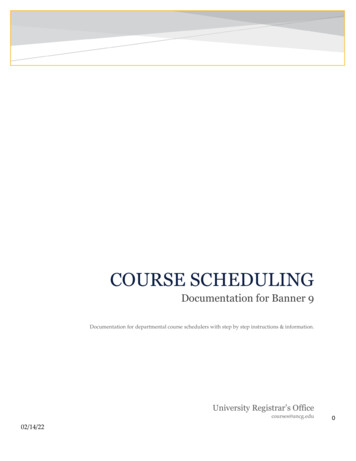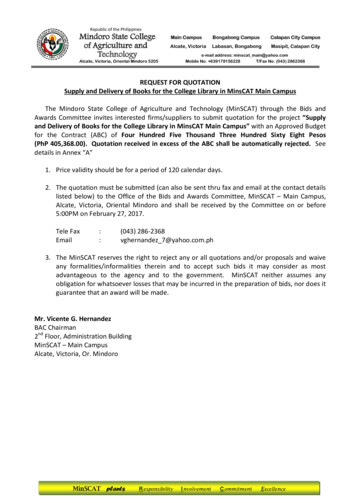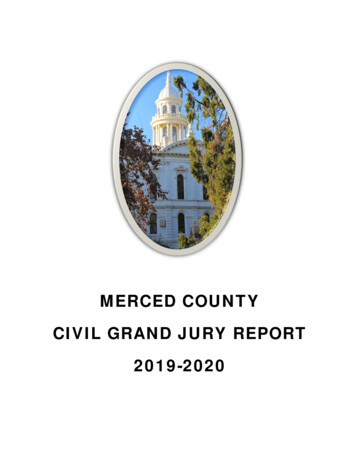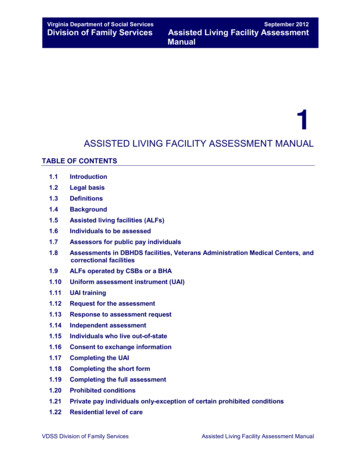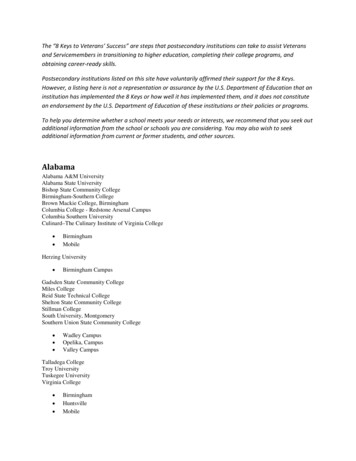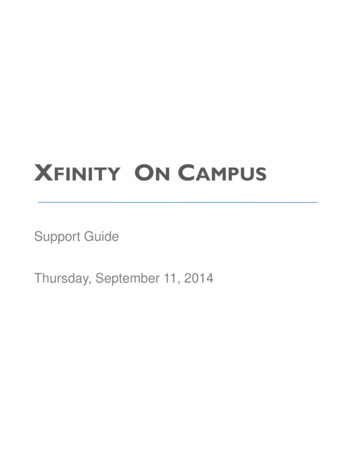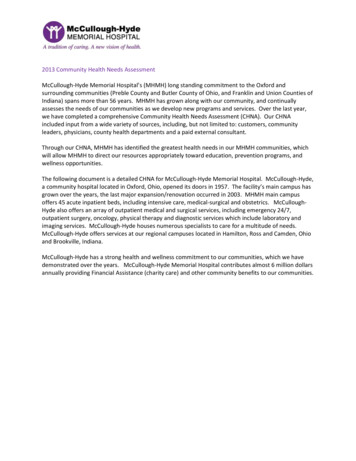
Transcription
2013 Community Health Needs AssessmentMcCullough-Hyde Memorial Hospital’s (MHMH) long standing commitment to the Oxford andsurrounding communities (Preble County and Butler County of Ohio, and Franklin and Union Counties ofIndiana) spans more than 56 years. MHMH has grown along with our community, and continuallyassesses the needs of our communities as we develop new programs and services. Over the last year,we have completed a comprehensive Community Health Needs Assessment (CHNA). Our CHNAincluded input from a wide variety of sources, including, but not limited to: customers, communityleaders, physicians, county health departments and a paid external consultant.Through our CHNA, MHMH has identified the greatest health needs in our MHMH communities, whichwill allow MHMH to direct our resources appropriately toward education, prevention programs, andwellness opportunities.The following document is a detailed CHNA for McCullough-Hyde Memorial Hospital. McCullough-Hyde,a community hospital located in Oxford, Ohio, opened its doors in 1957. The facility’s main campus hasgrown over the years, the last major expansion/renovation occurred in 2003. MHMH main campusoffers 45 acute inpatient beds, including intensive care, medical-surgical and obstetrics. McCulloughHyde also offers an array of outpatient medical and surgical services, including emergency 24/7,outpatient surgery, oncology, physical therapy and diagnostic services which include laboratory andimaging services. McCullough-Hyde houses numerous specialists to care for a multitude of needs.McCullough-Hyde offers services at our regional campuses located in Hamilton, Ross and Camden, Ohioand Brookville, Indiana.McCullough-Hyde has a strong health and wellness commitment to our communities, which we havedemonstrated over the years. McCullough-Hyde Memorial Hospital contributes almost 6 million dollarsannually providing Financial Assistance (charity care) and other community benefits to our communities.
IntroductionThis report identifies and assesses community health needs in the areas served by McCullough-HydeHospital in accordance with regulations promulgated by the Internal Revenue Service pursuant to thePatient Protection and Affordable Care Act, 2010.While McCullough-Hyde Hospital recognizes that a community health needs assessment (CHNA) isrequired to meet current government regulations and this assessment is intended to fulfill thispurpose, we also recognize the importance of this assessment in helping to meet the needs of ourcommunities.The CHNA was completed in 2013. The CHNA has identified the needs, but does not address whetherthose needs are being addressed by one or more community benefit programs already in existence.Rather, this assessment will serve as a foundation for developing an implementation strategy toaddress those needs that (a) the hospital determines it is able to meet in whole or in part; (b) areotherwise part of its mission; (c) are not met (or are not adequately met) by other program andservices in the service area.The MHMH CHNA is the foundation for an implementation strategy as required by the applicableregulations. MHMH is taking a leadership role in both the CHNA and the implementation strategies.CHNA’s seek to identify priority heath status and access issues for particular geographic areas andpopulations. We focused on the following questions when developing our CHNA:Who in the community is most vulnerable in terms of health status or access to care?What are the unique health status and/or access needs for this population?Where do these people live in the community?Why are these problems present?The question of how the hospital can best use its limited resources to assist communities in need will bethe subject of the hospital’s implementation strategy.To answer these questions, this assessment considered multiple data sources including secondary data(regarding demographics, heath status indicators, and measures of health care access), assessmentsprepared by other organizations in recent years, and primary data derived from interviews with personswho represent the broad interest of the community.The following topics and data have been assessed:DemographicsEconomic issues, e.g. poverty and unemploymentHealth status indicators, e.g. morbidity rates for various diseases and conditions, and mortalityrates for leading causes of deathCommunity issues, e.g. availability of healthcare facilities and recourses and environmentalconcernsHealth access indicators, e.g. uninsured, use of the emergency room for non-emergentconditions.MHMH CHNA- 1
Population ServedMcCullough-Hyde Memorial Hospital identifies it “community served” as the residents of 5 counties: InOhio: Butler and Preble and In Indiana Fayette, Franklin and Union. The breakdown by zip codes bycounties is as follows:Zip Codes: The following zip codes make up MHMH inpatient and ED visits.Butler County: 40.8%45056 (Oxford): 26.8%45011 and 45013 (Hamilton): 7.7%Other Butler County zips in Service Area: 6.3%Preble County: 22.8%45311 (Camden): 10.4%45320 (Eaton): 5.8%Other Preble County zips in Service Area: 6.6%Franklin County: 14.9%47012 (Brookville): 12.7%Other Franklin County zips in our service area: 2.2%Union County: 12.2%47353 (Liberty): 7.4%Other Union County zips in our service area: 4.8Fayette County: 3.5%Miscellaneous– outside service area 5.8%Map of MHMH Service areaMHMH main campusRoss CampusBrookville CampusCamden CampusHamilton CampusMHMH CHNA- 2
Information and Data Considered in Identifying Potential Need:Information and Data sources: Federal, State or Local or other departments or agencies.McCullough-Hyde Memorial Hospital participated in a regional Community Health Needs Assessmentprocess coordinated by the Greater Cincinnati Health Council. It contracted with a local nonprofitorganization, Health Care Access Now (HCAN), to prepare A Community Health Needs Assessment forSouthwest Ohio and Southeast Indiana. HCAN is dedicated to helping establish a high performing,integrated, health care delivery network able to provide access to care for all residents of nine countiesof Greater Cincinnati, including Hamilton, Butler, Clermont, Adams, Brown, and Warren in SouthwestOhio and Dearborn and Ripley in Southeast Indiana. As part of its preparation, HCAN performed thefollowing activities:1.Primary Data Collections Sources:Stakeholder Interviews: The stakeholders selected in each county consisted of oneperson in the following categories: county health commissioner, county mental healthboard, United Way, Community Action Agencies, community foundation, andcolleges/universities. Stakeholders chosen to represent each of these categories weredetermined through a combination of personal references, and online search. A fewstakeholders had some overlap, in that they represented multiple counties included inthe study. Refer to the Community Input Section of this report for individuals whoparticipated and the date of the interview.Direct Service Provider Focus Groups using Group Level Assessment (GLA) method:Invitations were distributed to target direct service providers/advocacy groups from thecounty in the following categories: non-English speaking, Federally Qualified HealthCenter (FQHC), free clinics, Visiting Nurses Associations, ex-offenders, seniors,transportation, Chambers of Commerce, school systems, inter-faith, legal aid, areaplanning, county extension, behavioral health, developmental disabilities, dental careand primary care. The total number of service providers participating at the county GLAevents ranged from a few as nine to as many as 30 people. Overall, approximately 200service providers across the 9 Ohio counties participated. Refer to the Community InputSection of this report for individuals who participated and the date of the focus groupparticipation.End-User Surveys: The University of Cincinnati Action Research Center surveyedpopulations in the greater Cincinnati region who are more often underserved with aparticular focus on heath care consumers who are uninsured, underinsured, lowsocioeconomic status, minority, 65 , or who experience mental health issues. Surveyswere administered to more than 1,000 community residents across the nine Ohiocounties with oversampling of vulnerable groups such as persons over 18 years of agewho have a behavioral health disorder; seniors; Hispanic/Latinos; and Africanimmigrants, particularly West African immigrants.2. Secondary Data Collection Sources:A. A Data Committee led by HCAN’s partner, Health Landscape, collected data from local,state and national sources, for the years of 2005-2011, via online search in order tocompile the Community Health Needs Assessment databaseRegional: Greater Cincinnati Community Health Status Survey, Greater CincinnatiHealth Council.State: Ohio Department of Health, Ohio Family Health SurveyMHMH CHNA- 3
National: 2010 Census, Annie E. Casey Foundation, Centers for Disease Control,Homeless Management Information Systems, Small Area Income and PovertyEstimates, Food Environment Atlas3. Other Data Collection Sources:A. Local:The Coalition for a Healthy Community – Oxford conducted a Community NeedsAssessment in 2012.McCullough-Hyde Memorial Hospital conducted focus group assessments in 2013Reviewed reports from Union county Indiana, Preble County Ohio and MiamiUniversityMHMH CHNA- 4
Process and Methods:Process for Gathering and Analyzing Data Information(IRS Notice 2011-52 Section 3.03(2))1. Primary Data Collections and Analysis Process: Process and methods used (includingparticipants involved and also the duration and number of meetings) to identify sources ofdata/information and the time period over which this occurred:Stakeholder Interviews: Letters were mailed to 50 stakeholder interview candidatesinviting them to participate in a 45-60 minute face-to-face interview. Thirty-twointerviews were conducted in-person by the Community Health Needs Assessment ProjectManager, Stephanie Marshall. Three out of six requests to complete an available onlinesurvey-monkey version were fulfilled. Three individuals declined, and eight individualswere unable to be scheduled due to lack of response. The interview questions weredrafted with input from the Community Health Needs Assessment Leadership Team andthe University of Cincinnati Action Research Center. They were subsequently narroweddown to a total of 17 questions in five different categories. The interviews were taperecorded with consent and the interviewer took high level notes for each question duringthe interview process. The invitations, question design and interviews occurred from JulyDecember 2011.Direct Service Provider Focus Group Level Assessment: The University of CincinnatiAction Research Center team conducted one Group Level Assessment (GLA) in each of thenine counties. Group Level Assessment is a participatory large group approach in whichqualitative data is generated about an issue of importance through an interactive andcollaborative process (Vaughn et al., 1998). The GLA allows for the identification of needsand priorities within a large group setting where the participants have the knowledge andexpertise to inform the research. Approximately 30 pieces of flip chart paper hung on thewalls. Each flip chart contained one or more prompts/questions. Example promptsincluded:“The most pressing health care need in our county is.”“If you could change one thing about the health care system in our county.”“Health care would be more accessible in our county if.”As a large group, service providers were instructed to provide responses to each promptin any order they preferred. After recording their responses, participants were instructedto walk around the room and look at other written responses. Participants then dividedinto smaller groups and were each given 5-7 flip chart pages. Small groups wereinstructed to discuss the responses on the charts and to identify 3-5 common themesacross the charts. After each small group identified salient themes from their flip charts,the larger group reconvened and each small group reported their findings in a “roundrobin” fashion with each group presenting one theme at a time. The primary facilitatorrecorded the major themes on a flip chart for the larger group to see. Then, participantsas a large group discussed overall themes, distilled themes through consensus, and chosethe most important priorities regarding health and healthcare in their county. If timepermitted, the larger group discussed possible next steps for their county. Meetingslasted approximately 90 minutes to two hours. GLA planning, designing and hostingoccurred between September-November 2011.End-Users surveys: The University of Cincinnati Action Research Center developed aseven page survey instrument using convenience and purposive sampling techniques. Thesample size was based on 2010 Census data. Thus, counties with a population up to50,000 people received 60 surveys. Other counties received a greater number of surveysin relation to increments of 200,000 people. Most questions tested between a 4th andMHMH CHNA- 5
6th grade reading level. Pre-testing was conducted with the target population andrevealed that there were no significant readability issues. The survey took between 11and 22 minutes to complete with most completing in less than 15 minutes. A 5 gift cardincentive was provided. This survey was designed to answer questions focused onbarriers to care. The survey instrument was a slightly modified Barriers to CareQuestionnaire (developed by Michael Seid, 2009) that was originally designed to measurepatient reports of difficulties with accessing or using healthcare. The Barriers to CareQuestionnaire has a total scale and five subscales: 1) pragmatics--logistical and costbarriers that might prevent or delay appropriate utilization; 2) skills--acquired or learnedstrategies to navigate through, manipulate, or function competently within the healthcare system; 3) expectations of receiving poor quality care; 4) marginalization-- theinternalization and personalization of negative experiences within the health care system;5) knowledge and beliefs-- lay or popular ideas about the nature and treatment of illness,which may differ from those of mainstream allopathic medicine. The survey includesvalidated measures including the initial barriers question. Surveys were administeredbetween August-November 2011.2. Secondary Data Collection Process: HCAN convened a Data Committee with volunteerrepresentatives from the United Way of Greater Cincinnati, Cincinnati Children’s HospitalMedical Center, Hamilton County Public Health Department, Mental Health Board, Health CareAccess Now, Greater Cincinnati Health Council, and the Butler County Educational ServicesCenter. The committee included people with database management and survey experience,planning experience and knowledge of special population groups. The data committee collectedover 300 heath-related indicators from secondary data sources via online search and exportedavailable data into one spreadsheet. The secondary data collection occurred over a nine monthperiod. The Data Committee met monthly from March 2011-November 2011. The followinginformational gaps have been identified:Indiana county and state -level dataRural Ohio counties (Highland and Adams in particular) county-level dataSome state-level benchmark data for Indiana and OhioZip-code or neighborhood level data for all counties except for selected indicators as notedin the Assessment report3. Other Data Collection Processes:The Coalition for a Healthy Community – Oxford Area. The Coalition developed aCommunity Needs Assessment. This assessment had input from Oxford and itssurrounding area’s social service agencies. Each agency provided 3-4 questions thatwould help them determine community needs and if those needs were being met.Questionnaires were provided to these social services agencies to get input from endusers and providers. Surveys were administered between February –April 2012McCullough-Hyde Memorial Hospital conducted focus group assessments. At the locallevel: Invitations were sent to local stakeholders (MHMH Medical Executive Committee,Coalition for a Healthy Community Leadership team , key community leaders, pediatricgroup, Union County Health Department, Franklin County Health Department andPreble County Health Department ) inviting them to participate in a face to faceinterview. 5 group interviews were conducted by the McCullough-Hyde MemorialHospital’s Community Health Needs Assessment Workgroup Chair, Sharon Klein. Theinterview questions were drafted with input from the MHMH Community Health NeedsAssessment Workgroup. The questions were:MHMH CHNA- 6
Who in the community is most vulnerable in terms of health status or access tocare?What are the unique health status and/or access needs for this population?Where do these people live in the community?Why are these problems present?Members of the MHMH Community Health Needs Assessment Workgroup took detailednotes at each session, for each question asked. The interviews occurred during themonths of January – March 2013.Review of county reports from Preble, Union and Franklin Counties. We also had inputfrom Miami University’s Department of International Studies, since we have such a largenumber of international students at Miami University.Analysis methods used:1. Primary and Secondary Data: Data analysis of primary sources was conducted by the ActionResearch Center and by HCAN’s Project Manager. The analysis occurred in November andDecember 2011 and included the following methods:a. Quantitative Analyses. Team members from the Action Research Center entered andchecked survey data in Excel. To analyze and summarize the survey data, they used SPSSstatistical software for descriptive statistics such as percentages and averages. Quantitativesurvey results are presented in a variety of formats including written summary, pie charts,bar charts, and tables.b. Qualitative Analyses. Individual-level qualitative data were generated by each serviceprovider in response to the different prompts during each county GLA. Because the GLA is aparticipatory process, the participants distilled and summarized themes from the flip chartsand prioritized needs for their county during the actual GLA. In the Community HealthNeeds Assessment report, GLA data is presented both by the individual county and as anaggregate across all nine counties to detect similarities and overlap of priorities.c. As part of the GLA summary, the Action Research Center presented a ROWS analysis. ROWSanalysis has been used within the organizational counseling, community consulting, healthpromotion and education fields to describe Risks and Opportunities as they pertain to theenvironment and Weaknesses and Strengths as they pertain to the person (Prilleltensky &Prilleltensky, 2006). ROWS is very similar to SWOT analyses typically used in business toevaluate strengths, weaknesses, opportunities and threats to a project. The Action ResearchCenter used a modification of ROWS in this project to describe the Risks, Opportunities,Weaknesses and Strengths as they pertain to health and healthcare in each of the ninecounties.d. For the key informant stakeholder interviews, Stephanie Marshall, Health Care Access Now’sCommunity Health Needs Assessment Project Manager, recorded each stakeholder’scomments in an Excel spreadsheet. Salient themes were summarized for each questionwithin counties and across all nine counties. The stakeholder interview data was used tosupport quantitative data findings and assist in the definition of gaps and trends inhealthcare in each county and for the region.e. A “Triangulation Summary and Recommendations” report was presented for each of thenine counties which incorporates and “triangulates” results from both the GLAs and thesurveys. Triangulation is an approach that ensures that results are consistent across theGLAs and surveys and allows for identification of areas in which there are differences. TheAction Research Center also presented “Overall Recommendations” which combinesrecommendations across GLAs, surveys, and vulnerable populations.f. All data analyses occurred in the months of November-December 2011.MHMH CHNA- 7
2. Other DataThe Coalition for a Healthy Community – Oxford Area Community NeedsAssessment: The Coalition looked for trends of needs and service gaps. They held atown meeting in the spring of 2012 to discuss conclusions and further actionsneeded.The MHMH Community Assessment team used an assessment grid to set priority ofneed. Key criteria for scoring included: population affected, ability to evaluateoutcomes, current community capacity to address the heath care need, severity ofthe health need. Weights were assigned to each category allowing for moremeaningful ranking among the healthcare needs.Butler County Summary of findings:Summary from HCAN’s A Community Heath Needs Assessment for Southwest Ohio and SoutheastIndianaIn Butler County, 137 residents completed the CHNA Community Health Survey, and 12 serviceproviders participated in the CHNA Group Level Assessment. Butler County CHNA Community HealthSurvey respondents had the most racial and ethnic diversity of the counties in the CHNA region, with 56percent of respondents being white, 43 percent Latino and12 percent African American. In addition, theButler County survey had the highest rate of primary Spanish speakers (41 percent). Most surveyrespondents were female (80 percent), not employed full-time (74 percent) and parents of childrenunder the age of 18 (69 percent). About 89 percent of respondents reported a household income below 40,000 per year, which is lower than the US Census’s report of median income in the county.Respondent age was skewed younger than Butler County as a whole, with 93 percent of respondentsbeing ages 49 or younger.Health Care UtilizationWhen asked where they most often went for health care for themselves, only 49 percent of respondentsreported going to private doctors and 39 percent to private dentists. These frequencies are somewhatlower than the total CHNA sample, where 62 percent reported going to private doctors and 56 percentto private dentists. Fifty-three percent of Butler County respondents said they had received a routinecheck-up in the last year. Average annual number of physician visits was 5.1. Service providers in thecounty cited health care accessibility as one of the most important and challenging issues in the county,particularly for vulnerable populations like Spanish speakers and people who are homeless.Health Behaviors and BeliefsAlthough about 22 percent of respondents have used natural products to treat medical conditions, mostButler County respondents were not regular users of complementary and alternative medicine practices.Like the total CHNA survey sample, respondents believed health professionals, changes in behavior andprayer and/or God are the most important factors in good health. Service providers believed the“culture of poverty” and generational poverty issues have a significant impact on the health behavior ofmany Butler County residents. Specifically, service providers believe that cultural factors related tochronic poverty are associated with lack of health empowerment, poor health literacy, high emergencydepartment use, high “no show” rates and lack of follow-up on health care issues.Sources of Health-Related InformationSurvey respondents reported most often turning to health care providers, television and the Internet tofind information about staying healthy. They turn to their health care provider, friends and coworkers orfamily members for information about health care and health insurance. Of all hospital-sponsoredevents, participants most often reported taking advantage of flu shots (23 percent), health fairs (19percent) and immunizations (15 percent), but less than 10 percent reported using any other hospitalsponsored service. Service providers identified several resources for information in Butler County, butMHMH CHNA- 8
they believed lack of care coordination and integration and difficulties navigating the system are majorbarriers to connecting consumers to these resources.Barriers to CareSurvey respondents were mostly likely to cite logistical and cost barriers to care. Seventy-seven percentof respondents reported that transportation did not prevent them from seeing a health careprofessional, and the majority did not have to travel more than 10 miles to reach the various health careservices they needed. Interestingly, the most commonly answered distance for mental health servicewas “don’t know,” which was similar to service providers’ feedback, who described a disconnectbetween consumer and mental health services. In general, survey results were different from those ofservice providers, who described transportation and lack of providers as two of the biggest barriers tohealth in Butler County.ConclusionsButler County has several unique populations that are particularly vulnerable, including a largepopulation of people who are homeless and a concentration of native Spanish speaking immigrants.Butler County also has 13.5 percent of the population living below the poverty level, and serviceproviders described several employers in the area that have recently laid off large numbers of workers.Taken together, the lack of centralized resources, the high numbers of poor and working poor and theneeds of diverse vulnerable populations create a particularly complex health care scenario in ButlerCounty.RecommendationsService providers identified “Unify the County” as a rallying cry for agencies to help improvecoordination of care and access to services. Service providers emphasized the need for coordination ofcare and centralized services. Butler County would benefit from a funded collaborative body withrepresentatives from the various health-related organizations and agencies around Butler County thatcan facilitate communication and the development of a system of coordinated care. This collaborativebody could include various levels of the community and corporate leaders, as well as direct serviceproviders to consumers.1. The need for resources specifically targeting people who are homeless was emphasized in ButlerCounty more than any other county. People who are homeless are particularly vulnerable tocoordination of care issues and systemic problems in accessing and following up on care.Preventive care is typically ignored by this group to deal with more pressing concerns. Futureefforts should partner with Butler County agencies already serving the homeless population toincrease care coordination and improve access to services.2. Butler County has high rates of poverty (13.5 percent) and unemployment (9.6 percent); serviceproviders describe significant difficulty serving the working poor who often do not qualify forHead Start or Healthy Families due to income limits. Working poor families often have no accessto health care services because insurance premiums, deductibles or co-pays are too high. Assuch, the working poor are identified as a particularly vulnerable population in Butler Countyand are a prioritized target for future resource development.3. Access to mental health and substance abuse services for all demographic groups was cited as asignificant problem in Butler County, particularly for those geographically distant from Hamiltonand Middletown. Service providers report a particular need for inpatient detox units andservices to address the extended effects of drug abuse on families and communities. Increasedaccess to mental health and substance abuse services is a priority for Butler County.MHMH CHNA- 9
4. Access to dental health professionals, particularly for the underinsured and uninsured, wasidentified as a major concern of service providers in Butler County. Outside of the morepopulated area surrounding Hamilton and Middletown, service providers report that dentalprofessionals are scarce.5. Hispanics/Latinos have different health beliefs that may or may not be aligned with Westernallopathic medicine. As Latinos and other immigrant populations increase in places like ButlerCounty, hospitals and health care agencies must offer services that appeal to an increasinglybroader range of consumers, and staff must be trained to practice in a culturally competentmanner.This Butler County map shows that the MHMH services area does not have large populations ofmedically underserved nor have health care professional shortages compared to other areas in thedistrict.MHMH CHNA- 10
Oxford Community Data SummaryWho are themostVulnerablein ourCommunity?Medical ExecutiveCommitteeYoung childrenLate teens/youngadults with chronicuntreated medicalproblemsUnemployed middleage adultsElderlyWhat are thebiggesthealthConcerns ofthispopulation?Loss of insurance –inability to access/payfor healthcareMental Health (#2problem at FreeClinic).Drug and AlcoholabuseObesity/MalnutritionDental care for adultswho do not haveaccess to privatedentist.Domestic AbuseTobacco use: hasbeen a problem for along time with littlesuccess in change ofbehaviorWhere dothese peoplelive?In rural areas of Butler,Preble Counties Ohio andFranklin, Fayette andUnion Counties, IndianaWhy aretheseproblemspresent?Poverty, Ignorance,gluttony, Avarice, greed,envy, prideCoalition for a Healthy Community and othercommunity leadersThose living in poverty, uninsured or underinsured or those who lack insurancecoverage for current needsThe chronically illThe unemployedMental Health – older adults and caregiversAlcohol and other drug dependant olderadults and youthRural areas with lack of transportationNon English speaking individualsHomeless – growing concern in OxfordOxford PediatricsCan’t afford medications and preventivecareLack of mental health servicesLack of Alcohol and other drug tre
The following document is a detailed CHNA for McCullough-Hyde Memorial Hospital. McCullough-Hyde, a community hospital located in Oxford, Ohio, opened its doors in 1957. The facility's main campus has grown over the years, the last major expansion/renovation occurred in 2003. MHMH main campus




